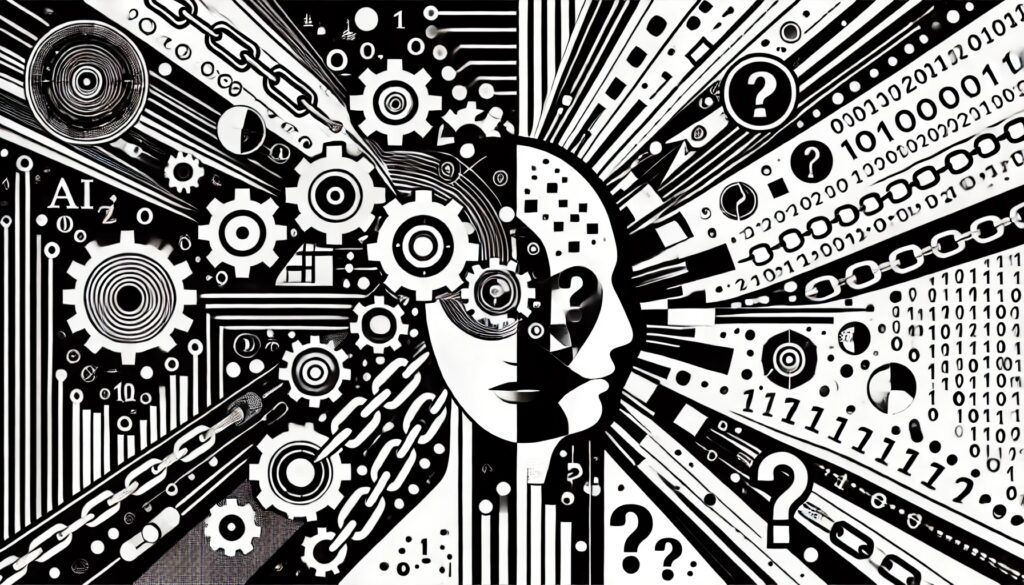In recent years, various industries have turned their attention to artificial intelligence (AI), which has garnered immense interest.
Experts widely regard AI as a transformative force reshaping our lives and workplaces, from automating routine tasks to personalizing healthcare. However, AI’s complex nature demands a multidisciplinary approach to fully grasp its capabilities and limitations.

This article delves into AI’s fundamentals, tracing its history and unpacking key concepts. It also examines AI’s technical facets, including machine learning and natural language processing.
Furthermore, we will investigate AI’s diverse applications in healthcare, finance, and transportation, and address the ethical and societal challenges it poses, such as privacy concerns, potential biases, and the impact on employment.
Key Takeaways
- Artificial Intelligence is a complex field that requires a multidisciplinary perspective to fully understand its capabilities and limitations.
- The foundations of AI include its history and key concepts, while the technical aspects of AI include machine learning and natural language processing.
- AI has various applications in fields such as healthcare, finance, and transportation, but also raises ethical and societal implications related to privacy, bias, and job displacement.
Foundations of Artificial Intelligence
History and Evolution
Artificial Intelligence (AI) merges disciplines like computer science, mathematics, engineering, psychology, and linguistics to create intelligent machines that perform tasks akin to humans. The AI concept has ancient roots, but it formally began in the mid-20th century.
British computer scientist Christopher Strachey led the way in 1951 by developing the first AI program, a checkers-playing algorithm for the Ferranti Mark I computer. The Dartmouth Conference followed in 1956, a landmark event orchestrated by John McCarthy, Marvin Minsky, Nathaniel Rochester, and Claude Shannon. This conference, considered the birthplace of AI, brought together experts from various fields to discuss the creation of intelligent machines.
AI has since evolved significantly, with advancements in machine learning, natural language processing, computer vision, and robotics. Today, AI is integral to numerous sectors, including speech recognition, image analysis, autonomous vehicles, and healthcare.
Key Concepts and Terminology
AI is based on several key concepts and terminology, including:
- Machine Learning: A subset of AI that involves training machines to learn from data without being explicitly programmed.
- Natural Language Processing: The ability of machines to understand and generate human language.
- Computer Vision: The ability of machines to interpret and analyze visual information.
- Robotics: The design and development of machines that can perform tasks autonomously.
Other important concepts include neural networks, deep learning, reinforcement learning, and expert systems.
Major Theories and Models
There are several major theories and models in AI, including:
- Symbolic AI: A model that represents knowledge using symbols and rules, and manipulates them using logical reasoning.
- Connectionist AI: A model that represents knowledge using interconnected nodes, and learns by adjusting the strength of connections between nodes.
- Evolutionary AI: A model that uses principles of natural selection to evolve solutions to problems.
These models have been used to develop a wide range of AI applications, from chess-playing programs to self-driving cars. As AI continues to evolve, researchers are exploring new theories and models to create even more intelligent machines.
Technical Aspects of AI
Machine Learning and Deep Learning
Machine learning and deep learning stand as pivotal subfields of artificial intelligence. It employs algorithms and statistical models that empower machines to learn from data, thereby making informed predictions or decisions. As a specialized branch of machine learning, deep learning utilizes artificial neural networks to tackle and model intricate issues.
These sophisticated algorithms find their use across a broad spectrum of applications, including image recognition, speech recognition, and natural language processing.
Natural Language Processing
Natural Language Processing (NLP), a branch of artificial intelligence, concentrates on equipping machines with the ability to comprehend, interpret, and produce human language. Applications of NLP are extensive, encompassing chatbots, virtual assistants, and machine translation.
Techniques like sentiment analysis, named entity recognition, and topic modeling are tools that NLP algorithms utilize to derive meaning from human language.
Computer Vision and Pattern Recognition
Computer vision and pattern recognition, integral subfields of artificial intelligence, aim to empower machines with the capability to interpret and understand visual information. In computer vision, algorithms analyze and make sense of images and videos. Similarly, pattern recognition employs algorithms to detect patterns within data. These powerful algorithms are instrumental in a variety of applications, including object recognition, face recognition, and image segmentation.
Robotics and Perception
Robotics and perception, as subfields of artificial intelligence, focus on granting machines the ability to engage with the physical world. They employs robots to carry out tasks either autonomously or under human supervision.
Perception uses sensors and algorithms to give machines the capacity to sense and comprehend their surroundings. These algorithms play a crucial role in various applications, including autonomous vehicles, industrial automation, and healthcare robotics.
To summarize, artificial intelligence’s technical aspects are both varied and interdisciplinary. Subfields such as machine learning, deep learning, natural language processing, computer vision, pattern recognition, robotics, and perception are vital components of AI, finding use in an extensive array of applications.
Applications of Artificial Intelligence
Artificial Intelligence (AI) has numerous applications in various fields, ranging from healthcare to finance to transportation. In this section, we will explore some of the most significant applications of AI.
Healthcare and Medicine
AI holds the promise of transforming healthcare and medicine, offering more precise diagnoses, tailored treatments, and facilitating drug discovery. For instance, AI-driven medical imaging systems can identify early indicators of diseases like cancer. AI-enabled chatbots also assist patients in managing chronic illnesses such as diabetes.
Additionally, AI’s ability to sift through extensive medical data helps uncover patterns and insights, thereby enhancing clinical decision-making.
Finance and Economics
AI is revolutionizing the finance and economics sector by automating critical tasks like fraud detection, risk assessment, and investment management. AI-driven chatbots, for example, provide assistance to customers in banking and insurance sectors, and AI-based trading algorithms enable quicker, more informed investment choices.
Moreover, AI’s capability to scrutinize market trends and consumer behavior plays a significant role in forecasting economic outcomes and shaping business strategies.
Automotive and Transportation
AI significantly impacts the automotive and transportation industry by facilitating the development of self-driving cars, enhancing traffic flow optimization, and advancing logistics.
AI-equipped sensors and cameras, for instance, are capable of detecting obstacles and executing real-time decisions for safe road navigation. Furthermore, AI’s analysis of traffic patterns and demand predictions contributes to the optimization of transportation routes and the alleviation of congestion.
Smart Cities and Infrastructure
AI is revolutionizing urban and infrastructural operations by introducing smart systems capable of monitoring and managing energy, water, and waste. For example, AI-enabled sensors actively detect leaks and anomalies in water systems, and AI-driven energy management systems optimize energy consumption to cut costs.
Moreover, AI analyzes data from multiple sources to guide urban planning and enhance sustainability.
In conclusion, AI’s ability to enable more precise and efficient processes, generate insights, and refine decision-making holds the potential to transform a variety of fields. With ongoing advancements in AI technology, we anticipate a future enriched with innovative applications that will bring widespread benefits to society.
Ethical and Societal Implications
Ethical Considerations
Artificial intelligence (AI) holds the transformative power to reshape our living and working environments, yet it simultaneously presents ethical dilemmas. The risk of AI reinforcing bias and discrimination stands as a critical issue. Biased data can teach machine learning algorithms to make prejudiced decisions, resulting in inequitable consequences for specific groups.
Moreover, the misuse of AI for harmful activities, such as operating autonomous weaponry or creating deepfake content, poses another ethical challenge.
With AI’s advancing capabilities, it becomes crucial to contemplate its potential repercussions and to formulate ethical standards that ensure its responsible and advantageous application.
AI and Employment
AI’s emergence has sparked debates regarding its influence on job markets. Although automation may replace certain jobs, AI equally harbors the capacity to generate novel jobs and sectors. Assessing AI’s potential effects on employment and devising strategies to equip the workforce for the evolving job landscape are essential considerations.
Privacy and Security
AI’s dependence on substantial data volumes for learning and decision-making amplifies privacy and security concerns. Safeguarding personal data and fortifying AI systems against cyber threats are imperative. This necessitates a blend of technical measures and regulatory policies to guarantee AI’s ethical and responsible utilization.
Regulation and Policy
The growing presence of AI underscores the need for establishing regulatory frameworks and policies that govern its ethical use. Crafting standards for data privacy and security, along with guidelines for AI’s development and deployment, is vital. Engaging a broad spectrum of stakeholders in policy formulation is key to ensuring their effectiveness and addressing the diverse concerns involved.
Frequently Asked Questions
How is artificial intelligence impacting societal structures and firms?
Artificial intelligence is transforming the way firms operate across industries. It is impacting societal structures by changing the nature of work, creating new forms of labor, and increasing productivity. AI technologies are also enabling firms to gain a competitive advantage by reducing operational costs, improving customer experience, and providing insights into consumer behavior.
In what ways can artificial intelligence be applied within the public sector, and what challenges arise?
Artificial intelligence has the potential to revolutionize the public sector by enabling government agencies to provide better services, improve decision-making, and increase efficiency. However, there are also challenges associated with the adoption of AI in the public sector. These include concerns around privacy, data security, and the potential for bias in decision-making.
What are the key insights from social sciences that explain artificial intelligence?
Social sciences provide valuable insights into the social and ethical implications of AI. Key insights include the impact of AI on employment, the potential for bias in decision-making, and the need for transparency in the development and deployment of AI technologies.
How does artificial intelligence contribute to firm performance?
Artificial intelligence can contribute to firm performance by improving operational efficiency, reducing costs, and enabling firms to make better decisions. AI technologies can also help firms to identify new business opportunities and gain a competitive advantage in the marketplace.
What are the interdisciplinary approaches to studying artificial intelligence?
Studying artificial intelligence requires an interdisciplinary approach that draws on the expertise of scholars from a range of fields, including computer science, engineering, mathematics, psychology, and philosophy. Interdisciplinary approaches can help to address the complex ethical and social implications of AI.
How is artificial intelligence defined within scholarly literature?
Artificial intelligence is defined as the ability of machines to perform tasks that would normally require human intelligence, such as learning, problem-solving, and decision-making. The field of AI encompasses a range of technologies, including machine learning, natural language processing, and robotics.





